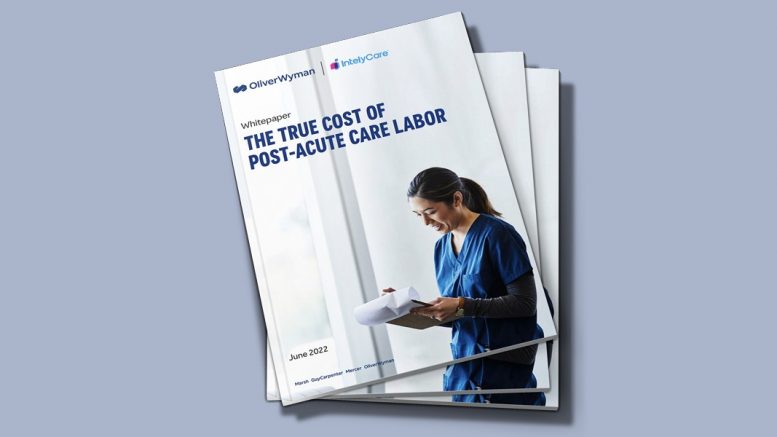Data from Oliver Wyman and Mercer shows that contingent nursing labor provides healthcare facilities with a cost-effective means of operating at full census to increase revenue and positive profit margins without burning out full-time staff
IntelyCare, a tech-enabled nurse staffing platform, announced the results of a commissioned study aimed at understanding the financial impact that the nurse staffing crisis is having on post-acute care facilities. Conducted by global management consulting leader Oliver Wyman, the study reveals that because of lower occupancy rates (down 14% since 2020) due to understaffing, the post-acute care industry is estimated to have $19.5BN in unrealized revenue by the end of 2022. With many facilities desperate to improve staffing levels to increase occupancy and drive positive profit margins, the study also provides a comparative assessment of nursing labor costs, finding that a full-time nursing employee can cost a facility up to 33% more on an hourly basis than an equivalent contingent worker.
As organizational funding and reimbursement are tied to patient volumes, every unoccupied bed represents a loss of revenue for a healthcare facility. The inability to increase patient referrals is hitting the post-acute care space particularly hard, as occupancy rates in some U.S. regions have dropped to nearly 60% from the 72% to 87% averages seen between 2015-2019. The study suggests that the issue will be further exacerbated by the Centers for Medicare & Medicaid Services’ (CMS) planned revisions to nursing home regulations.
“While staffing challenges have persisted in nursing homes for decades, it has become extremely difficult since the pandemic to maintain the workforce needed to reach full census. As a result, facilities lost between $2,656 and $7,771 a day in 2020 and 2021 and are estimated to lose between $2,330 to $5,882 this year,” said Deirdre Baggot, Partner at Oliver Wyman. “To increase admissions, it’s imperative that post-acute care facilities rethink how they manage their workforce and start to spend more strategically on staffing.”
For healthcare facilities, the study finds that supplementing full-time nursing staff with contingent labor not only provides a path to increase occupancy but is a cost-effective way of doing so. While contingent labor is perceived to come at a “premium” cost because of the often-higher wage rate, simply comparing hourly wages across contingent and full-time labor is misleading. Traditional staffing agencies and newer, tech-enabled staffing providers cover payroll taxes, recruitment and credentialing costs, retention bonuses, and a host of other expenses and benefits normally borne by healthcare facilities. The study, backed by industry data from global asset management and HR consulting firm, Mercer, found that on an hourly basis, a full-time employee costs a facility between 1.9 – 2.2x their hourly wage rate. Because of the additional expenses, the cost of filling a shift with a full-time registered nurse is 33% higher than the contingent labor rate that is being paid. For nursing assistants, the cost is 26% higher than the contingent labor rate.
The ancillary staffing expenses can represent 36 – 43% of the total cost of a full-time employee. As demand for skilled nursing labor continues to rise in the current market, recruitment expenses can account for 13% of the total cost of a new full-time registered nurse. Health benefits are also extremely costly to employers, reaching up to the equivalent of three additional months of wages each year.
The use of contingent nursing labor can help alleviate the burden on a healthcare facility’s full-time staff as well, minimizing attrition and turnover. According to Oliver Wyman, hours worked have increased by up to 15% across the nursing workforce due to understaffing. Nurses are now working more than the typical 36 hours per week pre-pandemic norm, while nursing assistants are working nearly 52 hours per week on average. Nearly 60% of the nursing professionals who left their jobs cited insufficient staffing as the reason for their departure. Therefore, improving staffing levels with contingent labor can enable facilities to increase job satisfaction and morale among their full-time nursing staff.
“Post-acute care facilities have to view contingent nursing labor, or ‘agency staff,’ not as a necessary evil, but rather a strategic, cost-effective resource that positively impacts their entire workforce and bottom line,” said David Coppins, CEO and Co-Founder of IntelyCare. “Recruiting and retaining full-time nurses has become an expensive uphill battle in today’s market. By allocating 15% to 20% of their workforce to contingent labor, facilities can operate at full census to maximize their revenue and finally relieve some of the pressure on their full-time staff, ultimately improving morale and retention.”
Get the complete report here >>
https://www.intelycare.com/research-group/the-true-cost-of-post-acute-care-labor/

